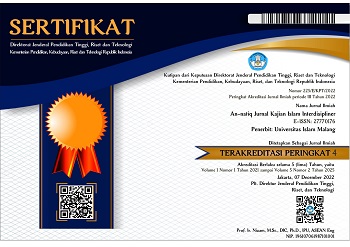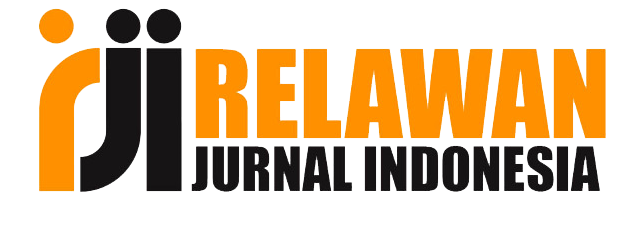PENGGUNAAN AYAT-AYAT AL-QUR’AN SEBAGAI MENTRE DALAM TRADISI MASYARAKAT SASAK
DOI:
https://doi.org/10.33474/an-natiq.v3i1.19183Keywords:
Mentre, verses of the Qur’an, Sasak societyAbstract
The phenomenon of using the verses of the Qur’an as a mentre (mantra) in the traditions of the Sasak people is still developing today. However, the fact is that in several ways there is a discrepancy between the meaning of the Qur'anic verses used and its intended function. These verses are used as mentre only because they have the same homophone (sound) with the Sasak dialect or language. This study aimed to reveal how the reception of the Sasak people to the use of verses of the Qur’an as a mentre in which has phonological similarities (homophones) with Sasak vocabulary or dialect. The research data was taken from interviews with several community leaders in Darmaji village, Kopang sub-district, Central Lombok who had in-depth knowledge of ministers. This study used a qualitative method with a phenomenological approach as an analytical tool. The results of the study showed that the use of inconsistent verses of the Qur’an (meanings and functions did not match) was a form of the Sasak people's belief in the power of the Qur’an. In addition, the incompatibility in the meaning of the Qur'an which was adapted based on the sound similarity with the Sasak dialect was a form of creativity of the Sasak people in interpreting the Qur'an. In line with that, the authors conclude that the phenomenon that occurs in the mentre tradition of the Sasak people is a form of community of the Qur’an in a magical space.
References
Agusman, & Mahyudi J. (2021) “Mantra masyarakat Sasak: Kajian bentuk, fungsi, dan aspek teologi”. Jurnal Satwika: Kajian Ilmu Budaya dan Perubahan Sosial, 5(2).
Akastangga M.D.B., (2021). “Dialek Sebagai Identitas Masyarakat Bahasa di Pulau Lombok”, Internasional Seminar on Austronesian Language and Literature IX.
Al-Bukhari, A.M, ( 2012). Ensiklopedia Hadits 2; Shahih al-Bukhari 2, trans. oleh Subhan Abdullah dkk, Jakarta: Almahira.
Al-Nawawi, (2010). Al-Tibyan fi Adabi Hamalti al-Qur’an, Fasl Fi al-Nafasi ma’a al-Qur’an li al-Ruqyah. Maktabah Dar al-Bayan.
Al-Naisaburi M., (2012). Ensiklopedia Hadits 4; Sahih Muslim 2, trans. oleh Masyhari dan Tatam Wijaya, Jakarta: Almahira.
Amin, (2022). “Wawancara di desa Darmaji”.
Esack F., 2007. The Qur’an, A User’s Guide, Oxford: Oneworld.
Fadlillah N., (2017). ”Resepsi Terhadap al-Qur’an dalam Riwayat Hadits”, Nun, 3(2).
Farhan A., (2017). “Living Qur’an Sebagai metode alternatif dalam studi al-Qur’an, El-Afkar, 6(2).
Humaeni A., (2014). “Mantra Masyarakat Muslim Banten,” El-Harakah, 16(1).
Hasan M.Z., (2020). “Resepsi Al-Qur’an Sebagai Medium Penyembuhan Dalam Tradisi Bejampi di Lombok” Jurnal Studi Ilmu-ilmu Al-Qur’an dan Hadits, 21(1).
Http://curcol.co/kamus-bahasa-sasak-lengkap-15722, diakse pada tanggal 15 Maret 2023 pukul 23:14.
Leavy, P. (2017). Research Design: Quantitative, Qualitative, Mixed Methods, Arts Based, and Comunity Based Participatory Research Appproaches. Guilford Press.
Lestari, & Jayanti E.T., (2020) “Magisme Islam Sasak: Fungsionalisasi Mantra Qur’an Sebagai Solusi Problematika Kehidupan Masyarakat Pedesaan di Lombok” Potret Pemikiran, 24(2).
Nasr S.H, (1981). Islam dalam Cita dan Fakta, Jakarta:LAPPENAS.
Mattson I., 2013. Ulumul Qur’an Zaman Kita, Jakarta: Zaman.
Permatasari D., & Santosa O.P., 2015. “Wawasan Budaya Nusantara Suku Sasak”, Prodi Televisi dan Film Jurusan Seni Media Rekam Fakultas Seni Rupa dan Desain Institut Seni Indonesia Srakarta.
Rahmat. (2022). “Wawancara di desa Darmaji”.
Rafiq A. (2014). “The Reception of The Qur’an in Indonesia: A Case Study of the Place of the Qur’an in a Non-Arabic Speaking Community”, Disertaation, ProQuest..
Robinson N., (2003). Discovering The Qur’an: A Contemporary Approach To A Veiled Text, Washington: University Press.
Rozzak S.A., (2020) “Transformasi Fragmen al-Qur’an dalam Magi: Studi atas Majmu;atul- Munawwar karya KH. Syafiq Munawwar”, Nun, 6(1).
Sanding U., (2022). “Wawancara di desa Darmaji”.
Shihab M.Q., (2007). Tafsir al-Misbah: Pesan, Kesan, dan Keserasian Al-Qur’an, Jakarta: Lentera Hati.
Yahya M., (2017). “Fragmen al-Qur’an dalam Kebudayaan Magis: Kajian atas Silah al-Mu’min karya Kiai Sya’roni” (Paper, Ujian Kompeherensif Konsentrasi Studi Al-Qur’an dan Hadits (SQH) Program Doktor (S-3) Program Pascasarjana UIN Sunan Kalijaga, Yogyakarta.
Downloads
Published
How to Cite
Issue
Section
License
Copyright (c) 2023 An-natiq Jurnal Kajian Islam Interdisipliner

This work is licensed under a Creative Commons Attribution-NonCommercial-ShareAlike 4.0 International License.


























